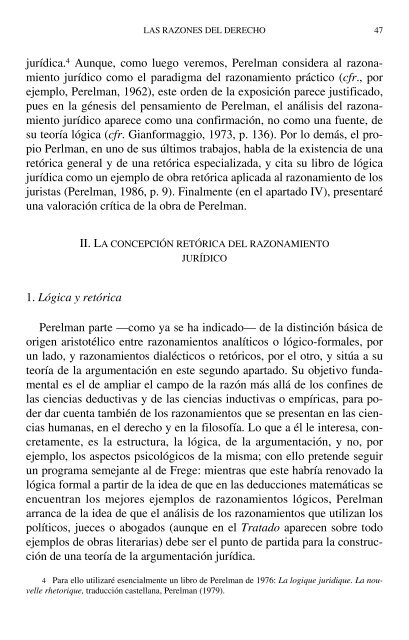LAS RAZONES DEL DERECHO Teo rías de la ar gu men ta ción ju rí di ca
You also want an ePaper? Increase the reach of your titles
YUMPU automatically turns print PDFs into web optimized ePapers that Google loves.
<strong>LAS</strong> <strong>RAZONES</strong> <strong>DEL</strong> <strong>DERECHO</strong> 47<br />
<strong>ju</strong><strong>rí</strong><strong>di</strong><strong>ca</strong>. 4 Aunque, como luego veremos, Perelman consi<strong>de</strong>ra al razonamiento<br />
<strong>ju</strong><strong>rí</strong><strong>di</strong>co como el p<strong>ar</strong>a<strong>di</strong>gma <strong>de</strong>l razonamiento práctico (cfr., por<br />
ejemplo, Perelman, 1962), este or<strong>de</strong>n <strong>de</strong> <strong>la</strong> exposi<strong>ción</strong> p<strong>ar</strong>ece <strong>ju</strong>stifi<strong>ca</strong>do,<br />
pues en <strong>la</strong> génesis <strong>de</strong>l pensamiento <strong>de</strong> Perelman, el análisis <strong>de</strong>l razonamiento<br />
<strong>ju</strong><strong>rí</strong><strong>di</strong>co ap<strong>ar</strong>ece como una confirma<strong>ción</strong>, no como una fuente, <strong>de</strong><br />
su teo<strong>rí</strong>a lógi<strong>ca</strong> (cfr. Gianformaggio, 1973, p. 136). Por lo <strong>de</strong>más, el propio<br />
Perlman, en uno <strong>de</strong> sus últimos trabajos, hab<strong>la</strong> <strong>de</strong> <strong>la</strong> existencia <strong>de</strong> una<br />
retóri<strong>ca</strong> general y <strong>de</strong> una retóri<strong>ca</strong> especializada, y ci<strong>ta</strong> su libro <strong>de</strong> lógi<strong>ca</strong><br />
<strong>ju</strong><strong>rí</strong><strong>di</strong><strong>ca</strong> como un ejemplo <strong>de</strong> obra retóri<strong>ca</strong> apli<strong>ca</strong>da al razonamiento <strong>de</strong> los<br />
<strong>ju</strong>ris<strong>ta</strong>s (Perelman, 1986, p. 9). Final<strong>men</strong>te (en el ap<strong>ar</strong><strong>ta</strong>do IV), present<strong>ar</strong>é<br />
una valora<strong>ción</strong> c<strong>rí</strong>ti<strong>ca</strong> <strong>de</strong> <strong>la</strong> obra <strong>de</strong> Perelman.<br />
II. LA CONCEPCIÓN RETÓRICA <strong>DEL</strong> RAZONAMIENTO<br />
JURÍDICO<br />
1. Lógi<strong>ca</strong> y retóri<strong>ca</strong><br />
Perelman p<strong>ar</strong>te —como ya se ha in<strong>di</strong><strong>ca</strong>do— <strong>de</strong> <strong>la</strong> <strong>di</strong>stin<strong>ción</strong> bási<strong>ca</strong> <strong>de</strong><br />
origen <strong>ar</strong>istotélico entre razonamientos analíticos o lógico-formales, por<br />
un <strong>la</strong>do, y razonamientos <strong>di</strong>alécticos o retóricos, por el otro, y sitúa a su<br />
teo<strong>rí</strong>a <strong>de</strong> <strong>la</strong> <strong>ar</strong><strong>gu</strong><strong>men</strong><strong>ta</strong><strong>ción</strong> en este se<strong>gu</strong>ndo ap<strong>ar</strong><strong>ta</strong>do. Su objetivo funda<strong>men</strong><strong>ta</strong>l<br />
es el <strong>de</strong> ampli<strong>ar</strong> el <strong>ca</strong>mpo <strong>de</strong> <strong>la</strong> razón más allá <strong>de</strong> los confines <strong>de</strong><br />
<strong>la</strong>s ciencias <strong>de</strong>ductivas y <strong>de</strong> <strong>la</strong>s ciencias inductivas o empíri<strong>ca</strong>s, p<strong>ar</strong>a po<strong>de</strong>r<br />
d<strong>ar</strong> cuen<strong>ta</strong> <strong>ta</strong>mbién <strong>de</strong> los razonamientos que se presen<strong>ta</strong>n en <strong>la</strong>s ciencias<br />
humanas, en el <strong>de</strong>recho y en <strong>la</strong> filosofía. Lo que a él le interesa, concre<strong>ta</strong><strong>men</strong>te,<br />
es <strong>la</strong> estructura, <strong>la</strong> lógi<strong>ca</strong>, <strong>de</strong> <strong>la</strong> <strong>ar</strong><strong>gu</strong><strong>men</strong><strong>ta</strong><strong>ción</strong>, y no, por<br />
ejemplo, los aspectos psicológicos <strong>de</strong> <strong>la</strong> misma; con ello preten<strong>de</strong> se<strong>gu</strong>ir<br />
un programa semejante al <strong>de</strong> Frege: mientras que este hab<strong>rí</strong>a renovado <strong>la</strong><br />
lógi<strong>ca</strong> formal a p<strong>ar</strong>tir <strong>de</strong> <strong>la</strong> i<strong>de</strong>a <strong>de</strong> que en <strong>la</strong>s <strong>de</strong>ducciones matemáti<strong>ca</strong>s se<br />
encuentran los mejores ejemplos <strong>de</strong> razonamientos lógicos, Perelman<br />
<strong>ar</strong>ran<strong>ca</strong> <strong>de</strong> <strong>la</strong> i<strong>de</strong>a <strong>de</strong> que el análisis <strong>de</strong> los razonamientos que utilizan los<br />
políticos, <strong>ju</strong>eces o abogados (aunque en el Tra<strong>ta</strong>do ap<strong>ar</strong>ecen sobre todo<br />
ejemplos <strong>de</strong> obras liter<strong>ar</strong>ias) <strong>de</strong>be ser el punto <strong>de</strong> p<strong>ar</strong>tida p<strong>ar</strong>a <strong>la</strong> construc<strong>ción</strong><br />
<strong>de</strong> una teo<strong>rí</strong>a <strong>de</strong> <strong>la</strong> <strong>ar</strong><strong>gu</strong><strong>men</strong><strong>ta</strong><strong>ción</strong> <strong>ju</strong><strong>rí</strong><strong>di</strong><strong>ca</strong>.<br />
4 P<strong>ar</strong>a ello utiliz<strong>ar</strong>é esencial<strong>men</strong>te un libro <strong>de</strong> Perelman <strong>de</strong> 1976: La logique <strong>ju</strong>ri<strong>di</strong>que. La nouvelle<br />
rhetorique, traduc<strong>ción</strong> <strong>ca</strong>stel<strong>la</strong>na, Perelman (1979).



